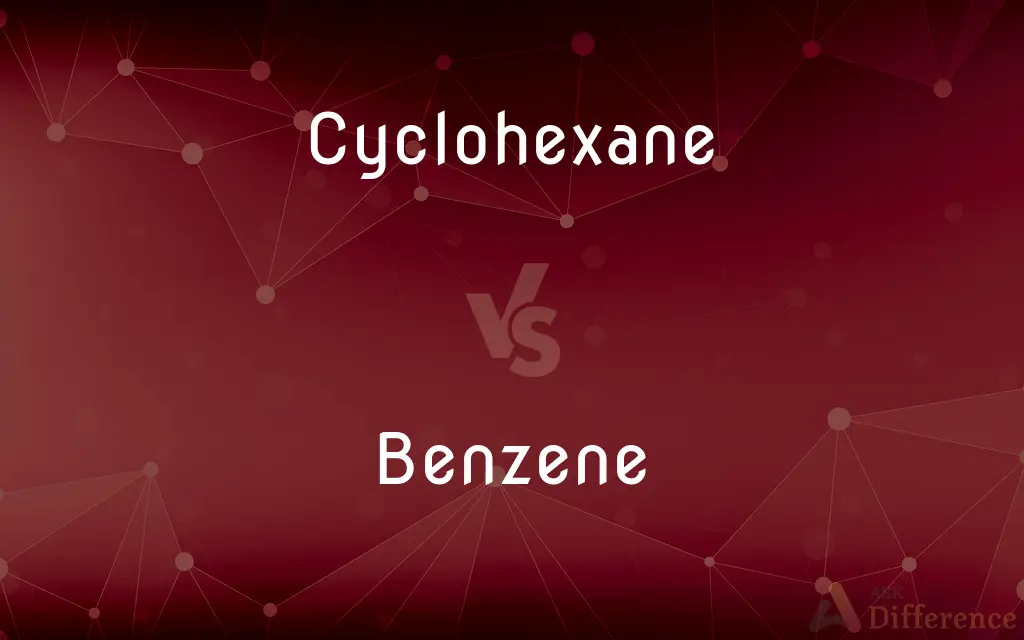Cyclohexane vs. Benzene — What's the Difference?
By Maham Liaqat & Urooj Arif — Updated on March 15, 2024
Cyclohexane is a saturated hydrocarbon with single bonds, while benzene is an aromatic hydrocarbon with a ring of alternating single and double bonds.

Difference Between Cyclohexane and Benzene
Table of Contents
ADVERTISEMENT
Key Differences
Cyclohexane is a cyclic alkane composed of six carbon atoms connected in a ring, with single covalent bonds between the carbon atoms, making it a saturated molecule. Benzene, on the other hand, is an aromatic hydrocarbon, known for its stable ring structure composed of six carbon atoms, but it features alternating single and double bonds, known as conjugation, contributing to its unique properties.
Chemically, cyclohexane is less reactive due to its saturated nature, lacking double bonds, which makes it relatively inert in the presence of many reagents. Benzene, despite having a conjugated ring, exhibits significant stability due to resonance, making it less reactive than typical alkenes but more chemically interesting due to its aromaticity.
In terms of physical properties, cyclohexane is a colorless, flammable liquid with a relatively high boiling point compared to other alkanes of similar molecular weight, due to its cyclic structure. Benzene is also a colorless, flammable liquid, but it has a distinctively sweet smell and is known for its carcinogenic properties, making it hazardous to human health.
Cyclohexane is often used as a non-polar solvent in chemical reactions or for industrial applications such as the production of nylon. Benzene is a key starting material in the synthesis of various chemicals, including plastics, resins, synthetic fibers, rubber, dyes, detergents, drugs, and pesticides, highlighting its importance in the chemical industry despite its toxicity.
The difference in the bonding and structure of cyclohexane and benzene leads to varied chemical behaviors and applications. While cyclohexane's lack of double bonds makes it a less reactive compound suitable for certain industrial uses, benzene's aromatic nature and conjugated system make it a cornerstone in organic chemistry, despite its associated health risks.
ADVERTISEMENT
Comparison Chart
Molecular Structure
Six carbon ring with single bonds (saturated).
Six carbon ring with alternating single and double bonds (aromatic).
Chemical Reactivity
Less reactive, due to saturation.
More stable than expected due to resonance, but still chemically versatile.
Physical Properties
Colorless, flammable liquid.
Colorless, flammable liquid with a sweet smell.
Health Effects
Relatively low toxicity.
Known carcinogen, posing significant health risks.
Uses
Solvent, industrial applications like nylon production.
Production of plastics, resins, synthetic fibers, rubber, dyes, detergents, drugs, and pesticides.
Compare with Definitions
Cyclohexane
A saturated cyclic alkane with the formula C6H12.
Cyclohexane is used as a solvent in some laboratory reactions due to its non-polarity.
Benzene
An aromatic hydrocarbon with the formula C6H6, characterized by a ring of six carbon atoms with alternating double bonds.
Benzene is foundational in understanding aromatic chemistry in organic synthesis.
Cyclohexane
A non-polar solvent widely used in industrial applications.
In the industry, cyclohexane is utilized in the extraction of essential oils.
Benzene
A colorless, highly flammable liquid with a sweet smell, known for its carcinogenic properties.
Despite its usefulness in the chemical industry, benzene's exposure is tightly controlled due to health risks.
Cyclohexane
A compound used in the manufacture of nylon and other synthetic fibers.
Cyclohexane is a key raw material in the production process of adipic acid, a precursor for nylon.
Benzene
A compound that exhibits resonance, giving it stability and unique reactivity among hydrocarbons.
The concept of resonance in benzene explains its unexpected chemical stability.
Cyclohexane
A chemical compound consisting of a ring of six carbon atoms, each bonded to two hydrogen atoms.
Cyclohexane's chair conformation is a stable form contributing to its chemical properties.
Benzene
A substance historically used as a solvent, though less common now due to health concerns.
Benzene was once widely used as a solvent in paints and varnishes.
Cyclohexane
A hydrocarbon with a cyclic structure, making it more stable than its linear counterparts.
The cyclic nature of cyclohexane gives it a higher boiling point than straight-chain alkanes of similar molecular weight.
Benzene
A key starting material in the synthesis of a wide range of chemicals and polymers.
Benzene is used in the manufacture of styrene, an important monomer for polystyrene plastics.
Cyclohexane
Cyclohexane is a cycloalkane with the molecular formula C6H12. Cyclohexane is non-polar.
Benzene
Benzene is an organic chemical compound with the molecular formula C6H6. The benzene molecule is composed of six carbon atoms joined in a planar ring with one hydrogen atom attached to each.
Cyclohexane
A colourless flammable liquid cycloalkane obtained from petroleum or by hydrogenating benzene, and used as a solvent and paint remover.
Benzene
A colorless, flammable, toxic, liquid aromatic hydrocarbon, C6H6, derived from petroleum and used in or to manufacture a wide variety of chemical products, including DDT, detergents, insecticides, and motor fuels. Also called benzol.
Cyclohexane
A flammable, colorless, mobile liquid cycloalkane, C6H12, obtained from petroleum and benzene and used in the manufacture of nylon and as a solvent, a paint remover, and a varnish remover.
Benzene
(organic compound) An aromatic hydrocarbon of formula C6H6 whose structure consists of a ring of alternate single and double bonds.
Cyclohexane
(organic compound) An alicyclic hydrocarbon, C6H12, consisting of a ring of six carbon atoms; a volatile liquid.
Benzene
Sometimes used in place of the phenyl group.
Benzene
A volatile, very inflammable liquid, C6H6, contained in the naphtha produced by the destructive distillation of coal, from which it is separated by fractional distillation. The name is sometimes applied also to the impure commercial product or benzole, and also, but rarely, to a similar mixed product of petroleum.
Benzene
A colorless liquid hydrocarbon; highly inflammable; carcinogenic; the simplest of the aromatic compounds
Common Curiosities
Why is benzene considered carcinogenic?
Benzene is carcinogenic due to its ability to cause DNA damage, leading to mutations and cancer.
Can cyclohexane be converted into benzene?
Yes, through dehydrogenation, cyclohexane can be converted into benzene by removing hydrogen atoms.
What distinguishes cyclohexane from benzene?
Cyclohexane is a saturated hydrocarbon with single bonds, while benzene is an aromatic hydrocarbon with alternating single and double bonds.
Why is benzene more reactive than cyclohexane?
Benzene's reactivity is due to its conjugated double bonds and aromatic nature, despite its resonance stability.
Are cyclohexane and benzene soluble in water?
Both cyclohexane and benzene are non-polar and thus have limited solubility in water.
How are cyclohexane and benzene used in everyday products?
Cyclohexane is used in the production of synthetic fibers like nylon, while benzene derivatives are found in plastics, resins, and synthetic rubber.
How is benzene regulated due to its toxicity?
Benzene's use and handling are strictly regulated in many countries, with guidelines to minimize exposure and protect workers.
What is the significance of resonance in benzene?
Resonance in benzene contributes to its chemical stability and is a key concept in understanding aromatic compounds.
What role does cyclohexane play in the chemical industry?
Cyclohexane is primarily used as a solvent and as a precursor in the production of nylon and other polymers.
What precautions are necessary when handling benzene?
Due to its toxicity, handling benzene requires proper protective equipment and ventilation to avoid inhalation and skin exposure.
Share Your Discovery

Previous Comparison
Zoom vs. Dolly
Next Comparison
Font vs. FountAuthor Spotlight
Written by
Maham LiaqatCo-written by
Urooj ArifUrooj is a skilled content writer at Ask Difference, known for her exceptional ability to simplify complex topics into engaging and informative content. With a passion for research and a flair for clear, concise writing, she consistently delivers articles that resonate with our diverse audience.















































